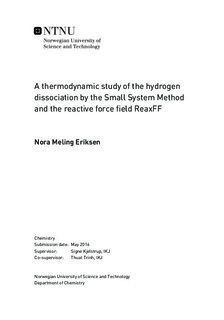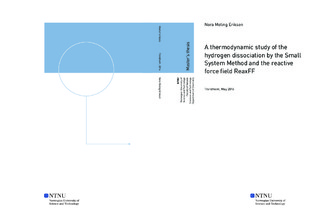| dc.description.abstract | The aim of this thesis was to study the reaction 2H=H2 using the reactive interaction potential ReaxFF. This was done by performing a thermodynamic study, using the ReaxFF and the Small System Method (SSM). The results were compared with several of the thermodynamic parameters from the article The reaction enthalpy of hydrogen dissociation calculated with the Small System Method from simulation of molecular fluctuations written by Skorpa et al. (2014) who used the reactive three-body potential (TBP). The ReaxFF was chosen because it is a popular interaction potential that is applicable with several chemical reactions and has low computational cost. An additional aim was conclude whether or not it was feasible to use the ReaxFF instead of the TBP and still get reasonable results.
In short, the ReaxFF produced fast calculations, which were consistent with expected trends. Here, the self-diffusion coefficient for H was larger than for H2, whereas the heat capacity for H2 was larger than for H. Furthermore, the activation energy was equal to the average bond enthalpy for hydrogen. By comparing the dissociation, partial molar enthalpy and the thermodynamic correction factor with the values in the Skorpa et al. paper, it was concluded that the ReaxFF compares to the TBP. Here, the ReaxFF and TBP values were equal, or close to equal. In general, the ReaxFF values had higher uncertainties and deviated more from the TBP when the particle number was low. This was expected since the ReaxFF is a less accurate potential, however, it was argued that it could also be an effect of the post-modelling processing.
During testing an error in the SSM code in LAMMPS was discovered; the code could not recognize molecules. Consequently, it could not be used in this study. This resulted in more post modelling calculations than expected, leading to a second SSM code in MATLAB being used in order to obtain the thermodynamic correction factor.
To conclude, the ReaxFF simulates hydrogen dissociation as expected. Furthermore, it is feasible to use the ReaxFF instead of the TBP. Despite the TBP being a more accurate potential, the ReaxFF produces close to the same values, is more applicable and faster. | |

